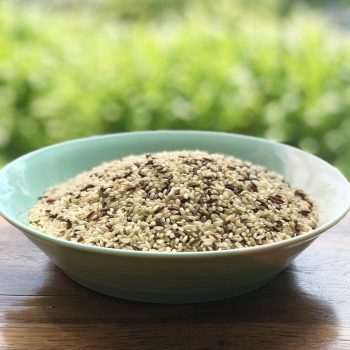 Some of you may have heard about arsenic contamination in rice, and might be wondering whether this is a concern for our health, or simply an overblown news story. Unfortunately, the bad news is that arsenic contamination in rice can pose a serious health concern, but fortunately, there are steps you can take to minimise your exposure so you can continue enjoying our delicious Spinach, Feta and Brown Rice Slice. But first let’s talk about what arsenic is, and why it might be a concern.
Some of you may have heard about arsenic contamination in rice, and might be wondering whether this is a concern for our health, or simply an overblown news story. Unfortunately, the bad news is that arsenic contamination in rice can pose a serious health concern, but fortunately, there are steps you can take to minimise your exposure so you can continue enjoying our delicious Spinach, Feta and Brown Rice Slice. But first let’s talk about what arsenic is, and why it might be a concern.
What is arsenic?
Arsenic is a naturally occurring metalloid, which means while not technically a metal, it has many of the same properties as metal. It’s normally found in trace amounts in the earth’s rock, soil and water supplies, but due to environmental contamination, is often found in excessive levels. Arsenic is used in rat poison, car batteries, ammunition and as a preservative for certain types of wood.
The type of arsenic typically found in contaminated crops is called inorganic arsenic. This type of arsenic is both highly poisonous and soluble in water, which means it can contaminate water supplies and be taken up by crops. Rice is particularly good at absorbing and storing this highly poisonous type of arsenic, because it is grown in flooded conditions. For this reason, rice can contain 10-20 times more arsenic than other cereal crops.
Why is arsenic contamination a concern?
Arsenic is a carcinogenic compound, meaning it promotes the formation and growth of cancer by damaging DNA. According to the World Health Organisation, arsenic exposure is associated with skin, lung and bladder cancer, as well as heart disease, developmental defects, lung disease and diabetes.
So what does the research say?
In 2015, the Swedish National Food Agency investigated 102 supermarket rice products for arsenic contamination. The researchers found rice cakes had the highest level of contamination of all rice products, followed by brown rice (as arsenic is stored in the bran and germ). Out of all the types of rice tested, basmati and jasmine rice had the lowest levels of arsenic. Unfortunately, organic rice products contained just as much arsenic as conventionally-grown rice. There was also minimal variation in arsenic content based on country of origin. A study published in 2015 suggested arborio and sushi rice may be the most contaminated varieties within the Australian market.
With this information, many of you may be wondering how much rice is too much. Unfortunately, rice has become quite ubiquitous in food manufacturing and is found in just about every aisle of the supermarket. In addition to bog standard brown and white rice, we have:
- Rice cakes
- Rice crackers
- Rice puffs (rice bubbles)
- Rice milk
- Rice flour
- Rice malt syrup
- Rice protein powder
- Rice bread
- Rice noodles
- Rice wine vinegar
- Rice puddings
- Rice cookies
- And more…
Rice flour is also a common ingredient in gluten free foods, so those on gluten free diets may be at risk of consuming even more rice than the general population. This level of rice consumption is a concern because it is difficult to quantify just how much arsenic we might be exposed to each day!
So how can we reduce our arsenic consumption?
Essentially, it’s time to ditch the Absorption Method when cooking rice. The researchers found the amount of arsenic in rice could be reduced by 40-70%, by cooking the rice in an excess of water and then rinsing and draining it before serving. This is because inorganic arsenic is water-soluble, so it leaches out of the rice and into the cooking water whilst boiling. It can then be drained off before serving.
The researchers also made some recommendations, to help you keep your arsenic exposure as low as possible. These recommendations included:
- Always boil rice with plenty of water (at least a 6:1 water-to-rice ratio), then drain and rinse before serving.
- Consume rice or rice products no more than a few times each week. Children especially should consume rice or rice products no more than four times weekly.
- Children under six should not consume rice cakes, due to their high level of contamination (here at Perth Health and Fertility, we encourage our patients to minimise their exposure wherever possible, so it’s probably best if the whole family give rice cakes a miss, especially as they’re pretty much the nutritional equivalent of cardboard!).
In addition, experiments have shown that soaking rice for 8 or so hours before cooking helps reduce arsenic content by up to 80%. For this reason, we recommend combining both methods (soaking and boiling) to reduce arsenic levels to an absolute minimum. You can check out the recipe HERE 🙂
Click the Links Below for Some More Reading on Arsenic
The Swedish National Food Agency Study
A resource from The World Health Organisation on arsenic
Assessment of arsenic in Australian and imported rice products (2015 Australian study)

